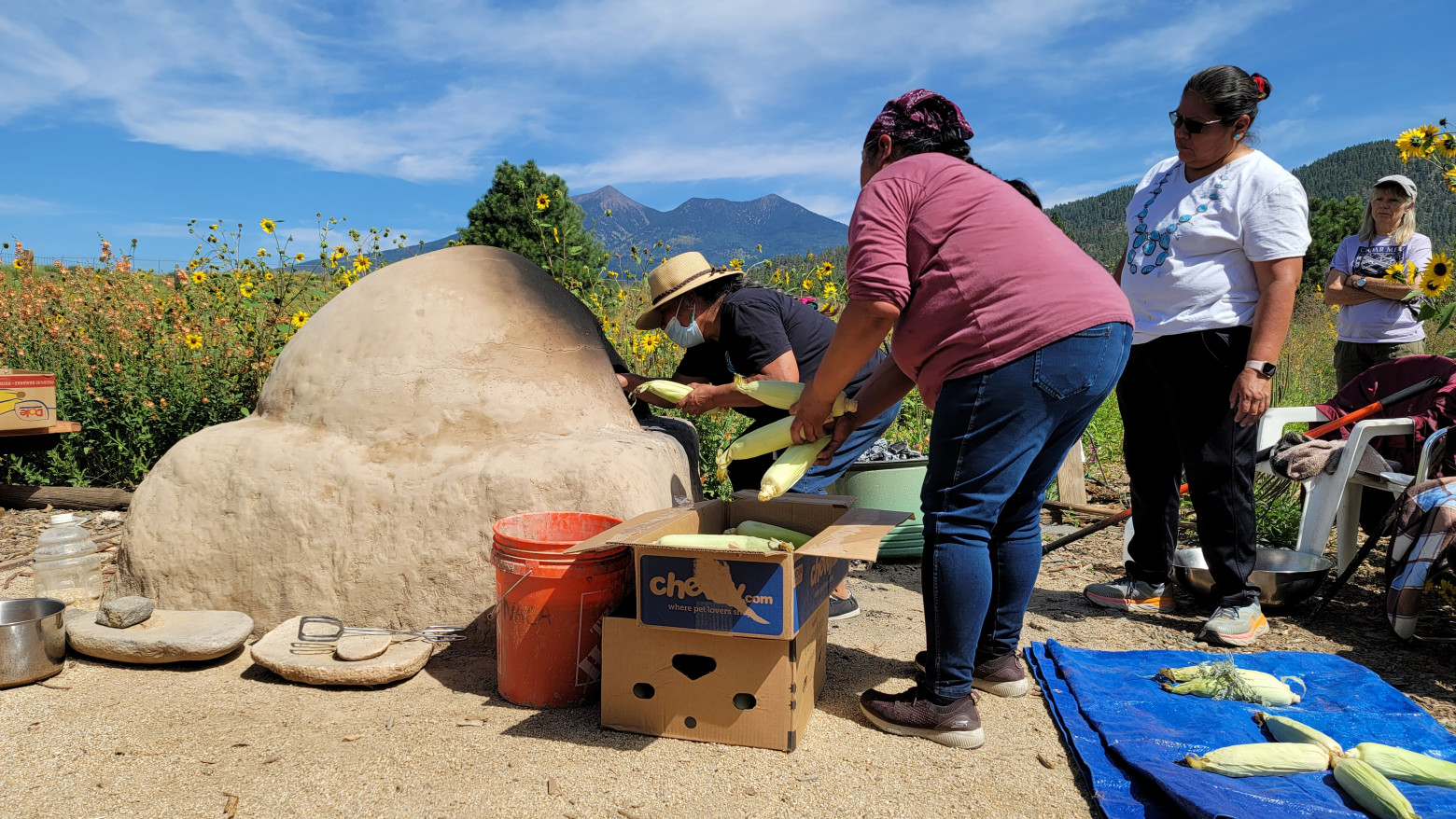
Three Indigenous women load corn into a traditional pueblo bread oven during a corn roasting demonstration. (Darrien Benally)

Three Indigenous women load corn into a traditional pueblo bread oven during a corn roasting demonstration. (Darrien Benally)
For two Indigenous environmental professionals, Natalia Shaw (Anishinabe/ Mexican American) and Robyn Jackson (Diné), incorporating their Indigenous heritage into their work is essential to moving toward climate justice for Southwest communities. In 2021, a historic drought dwindled the Lake Mead and Lake Powell water table to devastating levels. This event raised questions about Colorado River Basin tribal communities’ water rights and ignited a conversation about climate justice. The climate of the Western United States is expected to become drier and hotter over the next century.
According to a Yale study about the long-term impacts of land dispossession of tribes in the United States, tribal nations are especially vulnerable to climate change. This is because of government policies that forced tribes from their traditional homelands to locations that were considered undesirable by settlers. These areas often had poor soil and lacked drinkable water. Climate justice is about supporting tribal communities that have been made vulnerable to climate disruption due to colonization, helping such communities adapt to climate change, and promoting connections to land, people, and traditional ways.
Natalia Shaw works in the Sangre de Cristo Mountains, just outside Las Vegas, New Mexico. This area is where New Mexico’s largest recorded wildfire took place in 2022. The fire began from a prescribed burn and quickly turned into a high-intensity crown fire. A crown fire is one that spreads quickly from treetop to treetop. Due to decades of poor forest management leading to overgrowth and drought, the pine forest created a devastating blaze that displaced communities.
Shaw is an environmental scientist and educator who works for the New Mexico Forest and Watershed Restoration Institute. Part of her job is reconnecting youth and community members to the forests through education. Shaw believes, “forests and landscapes have always been influenced by humans- how do we continue to be land stewards?” She draws upon her interest in Anishinabe burning practices to connect to the Santa Fe National Forest and to teach others about plant identification.
Shaw helps youth foster a relationship to the land by identifying plant names and their uses. She knows that in order to restore a forest, the people in that community must have a meaningful connection to that land. In order to cultivate that connection, Shaw has guided youth tours through the Santa Fe National Forest forest to practice identifying plants.
“You can’t restore a forest if you don’t restore a connection to the land.” -Natalia Shaw
Forming a strong connection to the land is not just healing, but preventative as well. For example, Indigenous cultural burning practices prompted new plant growth and seed germination.
Shaw is committed to fostering reconnection to lands through her work as a key component of supporting solutions to the climate crisis. She knows the threat of climate change is monumental. However, she believes with access to current technology, we have the tools to move forward in light of climate change.
Robyn Jackson (Diné), fondly recalls spending her childhood in the Chuska Mountains, located on the Navajo Nation near Arizona and New Mexico border. She remembers abundant plant life and diverse insects like bumble bees and butterflies. There were vibrant springs teeming with tadpoles and lush forest meadows. The forested mountains were paradise in the Navajo Nation’s high-altitude desert. As Jackson grew older, the climate began to change. She noticed fewer bumble bees in the area and drying springs. Jackson and her family began to find it harder to find traditional medicinal plants, likely due to drought conditions and logging in the Chuska Mountains.
Jackson is a Diné woman from Wheatfields, Arizona. She is the Executive Director of Diné Citizens Against Ruining Our Environment (Diné C.A.R.E). Diné C.A.R.E is a Navajo-led environmental justice organization that works with Navajo communities affected by energy and environmental issues.
The Navajo Nation, where Jackson lives and works, was made vulnerable to climate change impacts such as drought and desertification due to natural resource extraction. In the 1940s, Navajo people and other tribal people were recruited to mine uranium ore for the U.S. government without proper protection. Today, there are hundreds of abandoned mines across the nation. Many of these mines are exposed and contaminate groundwater. Across the board, approximately 15% of people in the Navajo Nation lack access to clean drinking water.
Jackson’s parents are among the organization’s founding members who worked to protect the Navajo Nation from environmental threats. Indigenous People have deep knowledge about their environment; this is known as traditional ecological knowledge or TEK. Stories, songs, and ceremonies record and pass down this knowledge. Jackson draws upon traditional knowledge to find solutions that are climate justice focused. She does this by considering her Diné teachings of kinship to help communities organize against extractive industries through local action.
“Humans are part of a collective memory that honors lessons from the past for survival; our traditional teachings provide guidance,” Jackson said. She felt a generational call to help move the community forward to honor her parent’s legacy. Jackson believes that climate justice is about assisting communities to use their voice to prepare for the future of climate change and she leads community information sessions to listen to community members and educate them about current natural resource extraction activities across the Navajo Nation. Shaw’s and Jackson’s heritages provides a solid foundation to lead the climate justice movement forward.